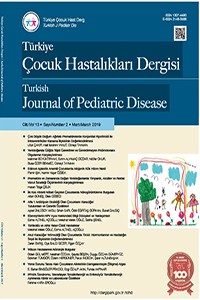Comparison of the Tympanic, Axillary and Rectal Temperature Measurements in Term and Preterm Newborns
Abstract
References
- 1. Robinson JL. Body temperature measurement in paediatrics: Which gadget should we believe? Paediatr Child Health 2004;9:457-9.
- 2. Robinson JL, Seal RF, Spady DW, Joffres MR. Comparison of esophageal, rectal, axillary, bladder, tympanic, and pulmonary artery temperatures in children. J Pediatr 1998;133:553-6.
- 3. Jean-Mary MB, Dicanzio J, Shaw J, Bernstein HH. Limited accuracy and reliability of infrared axillary and aural thermometers in a pediatric outpatient population. J Pediatr 2002;141:671-6.
- 4. Mariak Z, Bondyra Z, Piekarska M. The temperature within the circle of Willis versus tympanic temperature in resting normothermic humans. Eur J Appl Physiol Occup Physiol 1993;66:518-20.
- 5. Oncel MY, Tekgunduz KS, Ozdemir R, Calisici E, Karahan S, Erdeve O, Oguz SS, Dilmen U. A comparison of different methods of temperature measurement by mothers and physicians in healthy newborns. Indian J Pediatr 2013;80:190-4.
- 6. Stine CA, Flook DM, Vincze DL. Rectal versus axillary temperatures: Is there a significant difference in infants less than 1 year of age? J Pediatr Nurs 2012;27:265-70.
- 7. Craig JV, Lancaster GA, Taylor S, Williamson PR, Smyth RL. Infrared ear thermometry compared with rectal thermometry in children: A systematic review. Lancet 2002;360:603-9.
Prematüre ve Zamanında Doğan Yenidoğanlarda Timpanik, Aksiller ve Rektal Vücut Sıcaklığı Ölçümlerinin Karşılaştırılması
Abstract
Amaç: Yenidoğanlarda vücut sıcaklığının ölçümü için en çok aksiller ve timpanik ölçümler kullanılmaktadır. Çalışmada, prematüre ve zamanında doğmuş yenidoğanlarda, aksiller, timpanik ve rektal vücut sıcaklığı ölçümlerini karşılaştırmayı amaçladık.
Gereç ve Yöntemler: Çalışma Hacettepe Üniversitesi İhsan Doğramacı Çocuk Hastanesi Yenidoğan Yoğun Bakım Ünitesi’nde gerçekleştirildi. Çalışmaya alınan 100 hastada 100 aksiller, 100 timpanik ve 100 rektal ölçüm yapıldı. Farklı yöntemlerle ölçülen vücut sıcaklığı değerleri karşılaştırıldı.
Bulgular: Tüm çalışma grubunda rektal ve aksiller vücut sıcaklığı ölçümleri arasında kuvvetli (r: 0.74, p:0.000), rektal ve timpanik ölçümler ile aksiller ve timpanik ölçümler arasında ise zayıf korelasyon (r: 0.47 ve 0.59; p:0.000, p:0.000) saptandı.
Sonuç: Zamanında ve prematüre doğan bebeklerin vücut sıcaklığı izlemi en iyi aksiller ölçümlerle yapılabilir.
References
- 1. Robinson JL. Body temperature measurement in paediatrics: Which gadget should we believe? Paediatr Child Health 2004;9:457-9.
- 2. Robinson JL, Seal RF, Spady DW, Joffres MR. Comparison of esophageal, rectal, axillary, bladder, tympanic, and pulmonary artery temperatures in children. J Pediatr 1998;133:553-6.
- 3. Jean-Mary MB, Dicanzio J, Shaw J, Bernstein HH. Limited accuracy and reliability of infrared axillary and aural thermometers in a pediatric outpatient population. J Pediatr 2002;141:671-6.
- 4. Mariak Z, Bondyra Z, Piekarska M. The temperature within the circle of Willis versus tympanic temperature in resting normothermic humans. Eur J Appl Physiol Occup Physiol 1993;66:518-20.
- 5. Oncel MY, Tekgunduz KS, Ozdemir R, Calisici E, Karahan S, Erdeve O, Oguz SS, Dilmen U. A comparison of different methods of temperature measurement by mothers and physicians in healthy newborns. Indian J Pediatr 2013;80:190-4.
- 6. Stine CA, Flook DM, Vincze DL. Rectal versus axillary temperatures: Is there a significant difference in infants less than 1 year of age? J Pediatr Nurs 2012;27:265-70.
- 7. Craig JV, Lancaster GA, Taylor S, Williamson PR, Smyth RL. Infrared ear thermometry compared with rectal thermometry in children: A systematic review. Lancet 2002;360:603-9.
Details
| Primary Language | Turkish |
|---|---|
| Subjects | Internal Diseases |
| Journal Section | ORIGINAL ARTICLES |
| Authors | |
| Publication Date | March 26, 2019 |
| Submission Date | October 11, 2018 |
| Published in Issue | Year 2019 Volume: 13 Issue: 2 |
Cite
The publication language of Turkish Journal of Pediatric Disease is English.
Manuscripts submitted to the Turkish Journal of Pediatric Disease will go through a double-blind peer-review process. Each submission will be reviewed by at least two external, independent peer reviewers who are experts in the field, in order to ensure an unbiased evaluation process. The editorial board will invite an external and independent editor to manage the evaluation processes of manuscripts submitted by editors or by the editorial board members of the journal. The Editor in Chief is the final authority in the decision-making process for all submissions. Articles accepted for publication in the Turkish Journal of Pediatrics are put in the order of publication taking into account the acceptance dates. If the articles sent to the reviewers for evaluation are assessed as a senior for publication by the reviewers, the section editor and the editor considering all aspects (originality, high scientific quality and citation potential), it receives publication priority in addition to the articles assigned for the next issue.
The aim of the Turkish Journal of Pediatrics is to publish high-quality original research articles that will contribute to the international literature in the field of general pediatric health and diseases and its sub-branches. It also publishes editorial opinions, letters to the editor, reviews, case reports, book reviews, comments on previously published articles, meeting and conference proceedings, announcements, and biography. In addition to the field of child health and diseases, the journal also includes articles prepared in fields such as surgery, dentistry, public health, nutrition and dietetics, social services, human genetics, basic sciences, psychology, psychiatry, educational sciences, sociology and nursing, provided that they are related to this field. can be published.


